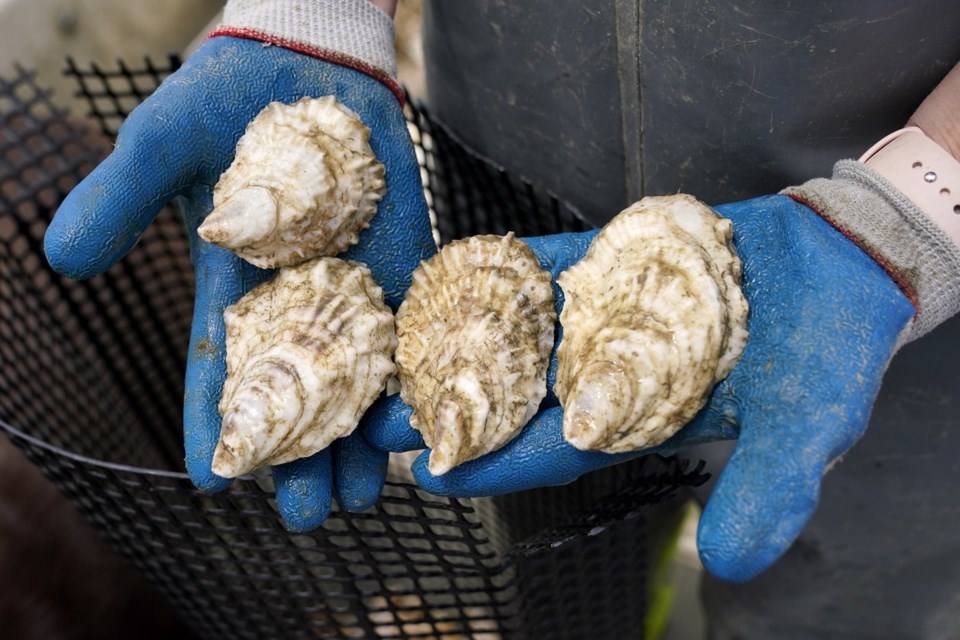SUMMERSIDE, P.E.I. — A "worrisome" parasite has been confirmed in at least one area on Prince Edward Island, and samples from several oyster farms have been sent for testing, says the Canadian Food Inspection Agency.
Danielle Williams, disease technical specialist at the federal agency, said the parasite called multinucleate sphere X — or MSX — has been confirmed in Bedeque Bay on the province's south shore.
"We haven't determined the amount of spread yet, but it is worrisome. It is very worrisome," she said in an interview Monday.
Several other sites are considered "under suspicion" of having the parasite and have been placed under quarantine as investigation continues to confirm whether it is present, including a location on Malpeque Bay on the province's north shore, she added.
"We have found another location in Malpeque area and so we have a few places under quarantine right now," she said. "What we did was that if a place was under suspicion, we placed it under quarantine until the testing results were finished."
She said the parasite likes to stay in "little pockets of areas," and if scientists are able to quickly identify and stop it from moving further, they can limit damage to the industry.
The parasite affects the growth of oysters and increases mortality, but there is no human health risk. Typically, cultivated oysters take about three years to reach market size, and the inspection agency said mortality rates from the disease can reach 90 to 95 per cent in older oysters.
The agency said MSX has previously been found in Nova Scotia and British Columbia, but this is the first time it has been detected in Prince Edward Island waters. Testing confirmed the presence of the parasite earlier this month after P.E.I. reported a "significant" oyster mortality in Bedeque Bay this spring.
Cory Deagle, fisheries minister for Prince Edward Island, called the presence of MSX in oysters in Bedeque Bay "devastating news."
"It isn’t just about the impact on our oyster industry, it is about the livelihood of Islanders, their families and our communities," he said in a statement last week.
"This is the first time we have had to deal with MSX in our province, and while MSX has been heavily researched over the years, scientists, researchers, and fishers around the globe still do not understand how the disease spreads. It will take time before we know the full extent of the impact on our industry."
A provincial government study said that in 2019 Prince Edward Island accounted for 32 per cent of the national economic value of oysters — about $54 million.
Peter Warris, executive director of the P.E.I. Aquaculture Alliance, said oyster growers are "very concerned" about the presence of MSX, something they have been dreading for years. "So it's bad news that it's finally arrived," he said.
Harvesters have not yet seen significant mortalities, he said, noting that the situation is evolving. "I think everyone's taking a bit of a pause in terms of their activities … waiting to see the results from the testing, to see where it has spread to," he said.
A publication from the Connecticut Department of Agriculture said MSX caused massive oyster mortalities in Delaware Bay in 1957 and two years later in Chesapeake Bay. While the parasite has been found in the United States from Florida to Maine, not all areas have been associated with oyster deaths, it said.
Warris said it is possible to have a thriving oyster industry in spite of MSX. "The industry will adapt to the new circumstances," he said.
Rod Beresford, an associate professor at Cape Breton University's biology department, said one of the challenges with the parasite is that in spite of it being around since the 1950s, there is not much known about its life cycle.
Scientists have tried to determine if the parasite has an intermediate host that allows it to move, he said. What they do know is that the infection is first seen in the oyster's gills — which is where oysters get their food — and replicates, eventually leading to the death of the host.
"For something that's been around for 60 years and caused this much economic and ecological damage, it's really, really surprising that we've not figured out its life cycle," Beresford said. "It's really a mystery."
In many diseases, proximity to an infected animal increases the likelihood of infection, but that is not always the case for MSX, said Beresford, who has been studying the parasite.
It is also not known exactly what temperatures, salinity or conditions result in this parasite eventually causing infection and disease. In the past, he said, researchers have put infected and non-infected oysters together in tanks and there was no spread. Oysters free from MSX were injected with tissue from a diseased animal but did not get infected, he added.
"We're missing a piece of the life cycle here," he said. "We know so little about this organism, it's shocking. … We're really stymied by this. It's a real challenge."
This report by The Canadian Press was first published July 23, 2024.
The Canadian Press




